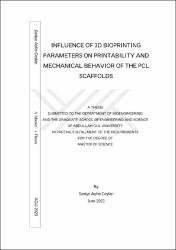Influence of 3D bioprinting parameters on printability and mechanical behavior of the PCL scaffolds
Abstract
Polycaprolactone (PCL) is a synthetic polymer that exhibits desirable properties such as biodegradability, tolerable mechanical properties, and biocompatibility for a diverse range of tissue engineering applications. In this study, we analyzed the effects of polymer concentration (10%, 25%, 50% and 75% w/v), solvent effect (dichloromethane, chloroform and acetic acid), and device parameters (pressure, speed, nozzle-surface distance, nozzle gauge, infill density) on printed scaffolds fabricated through 3D Bioprinting. Scanning electron microscopy (SEM) and optical microscopy were used to assess printability, and uniaxial tensile testing was performed to evaluate mechanical behavior. The aim of this study was to investigate the effects of different printing speeds (5 mm/s, 10 mm/s, and 15 mm/s) on the mechanical properties of PCL_DCM and PCL_CF scaffolds. The scaffolds printed at the lowest speed exhibited the highest ultimate tensile strength (UTS) values. Scaffolds printed at 5 mm/s with the highest printing pressure (480 kPa) demonstrated a remarkably high Young's modulus of 39.69 MPa and a UTS value of 6.4 for PCL_DCM, as well as Young's modulus of 26.80 MPa and a UTS value of 6.3 MPa for PCL_CF. Additionally, we investigated the influence of polymer concentrations (50% and 75%) and infill densities (50%, 70%, and 90%). The results showed that increasing the infill density and using a lower concentration (50%) led to improvements in Young's modulus and UTS values for both PCL_DCM and PCL_CF scaffolds. These results highlight the importance of carefully controlling printing parameters to optimize the mechanical properties of the printed scaffolds. Polikaprolakton (PCL), çeşitli doku mühendisliği uygulamaları için uygun özelliklere sahip, biyolojik olarak parçalanabilen sentetik bir polimerdir. Çalışmada polimer konsantrasyonu (%10, %25, %50 ve %75 w/v), çözücü etkisi (diklorometan, kloroform ve asetik asit) ve cihaz parametrelerinin (basınç, hız, nozul-yüzey mesafesi, nozul,dolgu yoğunluğu) etkisi basılabilirlik için tarama elektronu (SEM) ve optik mikroskopi ve mekanik davranış için tek eksenli çekme testi kullanılarak analiz edildi. Farklı baskı hızlarının (5, 10 ve 15 mm/sn) PCL_DCM ve PCL_CF yapı iskelelerinin mekanik özellikleri üzerindeki etkilerini araştırması amaçlamıştır. En düşük hızdaki iskeleleri, en yüksek nihai gerilme mukavemeti (UTS) değerlerini sergiledi. En yüksek baskı basıncıyla (480 kPa), 5 mm/s'de yazdırılan yapı iskeleleri PCL_DCM için 39,69 MPa'lık oldukça yüksek bir Young modülü ve 6,4'lük bir UTS değeri ve 26,80 MPa'lık bir Young modülü ve 6,3 MPa'lık bir UTS değeri gösterdi. Polimer konsantrasyonlarının (%50 ve %75) ve dolgu yoğunluklarının (%50, %70 ve %90) etkisini araştırmıştır. Dolgu yoğunluğunu artırmanın ve daha düşük konsantrasyonun (%50) hem PCL_DCM hem de PCL_CF yapı iskeleleri için Young modülü ve UTS değerlerinde iyileşmelere yol açtığını gösterdi. Bulgular, iskelelerin mekanik özelliklerini optimize etmek için baskı parametrelerini dikkatli bir şekilde kontrol etmenin önemini vurgulamaktadır.


















